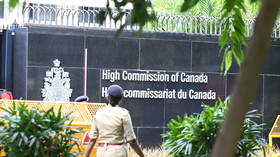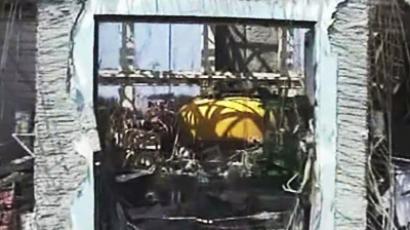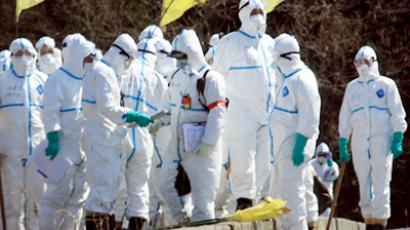TEPCO worried water might damage Fukushima building

Tokyo Electric Power Co. is cautious over injecting more water into one of its nuclear reactors. There are fears that the building might be further damaged due to the amount of water inside it.
The company is pumping water into the Fukushima reactors daily, but recently the situation surrounding the fourth reactor has become complicated, NHK television reported. On Friday, the temperature of water in the reactor’s pool reached 91 degrees Celsius, exceeding the norm by 50 degrees, and TEPCO had to inject 200 more tonnes of fresh water into it. However, the company announced that additional water might further damage the structure of the reactor building. Therefore, starting Saturday, the amount of water to be poured into the pool has been carefully estimated. A special device is used to control temperature and the level of cooling water in the pool, which contains 1,535 spent fuel rods. TEPCO is also considering building underground walls around the troubled Fukushima reactors to prevent radioactive water from seeping out, AFP news agency cited Japanese media as saying. Workers would reportedly have to dig to a depth of around 15 meters in order to start building the wall.TEPCO has yet to confirm or deny the information. “The company considers many possible course of action, and that may be one of them," the agency quoted the company’s spokesman as saying.
No future for troubled plant – governor
The latest developments come as governor of the Fukushima prefecture Yuhei Sato announced that that he will never allow TEPCO to resume operations at the Fukushima plant, Kyodo news agency reported. "A resumption of plant operations must not be possible," Sato told president of the Tokyo Electric Power Co. Masataka Shimizu, as quoted by the agency.Sato also demanded that the company pay for the damage to farmers and fisherman in the prefecture, and also to tourist operators and manufacturers. He also said that the workers who are currently battling the crisis at the plant should have better treatment and conditions. According to the latest report from TEPCO, at least 30 workers have been subjected to radiation exceeding the legal limit.Masataka Shimizu, in reply, apologized for the nuclear emergency and announced that he would step down from his post at an appropriate time to take responsibility for the disaster. Following the meeting, the TEPCO president paid a visit to a shelter in Koriyama at the Fukushima Prefecture. Shimizu kneeled down and begged the forgiveness of people who had had to evacuate from their homes near the plant. The situation with the evacuees remains tense and several of them expressed their anger over the situation they have been due to the crisis at the plant and subsequent introduction of the 20-kilometer evacuation zone. On April 21, an official no-entry zone was established around the Fukushima nuclear plant. The prefectural police increased the number of checkpoints at the roads leading to the zone from 10 to 65, The Asahi Shimbun newspaper reported.The people evacuated from the territory will be able to return to their homes in the near future, but only for a short period of time – five hours. According to Chief Cabinet Secretary Yukio Edano, the government wanted to begin allowing residents of the troubled area to return for short periods of time within the next few days, the newspaper reports. He also said that that the government has designated a planned evacuation area outside the 20-kilometer radius from the plant. Up to 10,000 residents will be asked to evacuate by the end of May. On Friday, Masataka Shimizu also visited several mayors in the prefecture and promised to take their demands for compensation seriously. In late March Shimizu was hospitalized for hypertension and dizziness as the company was trying to contain the nuclear crisis. The Fukushima crisis was triggered by the 9.0 magnitude earthquake and subsequent tsunami that hit northeastern Japan on March 11. The scale of the crisis is compared to Chernobyl catastrophe, which occurred back in 1986.
Fukushima crisis questions Japan’s nuclear future
Professor Paddy Regan from the Physics Department at the University of Surrey finds that, on a more specific scale, Fukushima-1 crisis is different from the Chernobyl accident, which hit the Soviet nuclear power plant in 1986.“They are different types of accident in both how they happened and in the release of radiation following the accident. Chernobyl was basically a mistake of design and an operating error. The result of the Chernobyl thing was that the reactor’s core exploded and for days on end, particles from the reactor core were open to the environment and there was an enormous release of radiation,” says Regan.The professor believes Japan is doing “a reasonably good job” solving the Fukushima’s crisis. He reminds that there are 50 more nuclear reactors in Japan that are still operational, even though some of them were also hit by the enormous earthquake in March. “If we look at these very dramatic scenes from Fukushima – it is not a perfect situation. But I suspect when we look at it 10-15 years from now it might seem something like a triumph that the reactors were shut down,” he adds.Still, Regan does not believe Japan will eagerly give up nuclear power now, the country being very oil-dependant and having limited natural resources.
Malcolm Grimston, an energy expert at Chatham House, does not think the crisis at Fukushima-1 nuclear power plant has been properly dealt with yet. He agrees that this is the second most serious accident after Chernobyl in history. “The speed of information coming out of Japan has not been as high as we would have hoped. On the other hand, they were dealing at the same time with the dreadful effects of the earthquake and tsunami and they are in situations they have never encountered before, so we should give them some leeway for that. But I do hope there is a proper investigation into that,” says Grimston. Still, Grimston does not believe Japan can abandon its nuclear energy program.“Japan imports 84 per cent of its energy. It is enormously dependent on imports from the Middle East, Russia, and the former Soviet Union. Gas from the same sort of regions has practically finished and Japan has used pretty much all of its coal. It doesn’t have enormously valuable renewable reserves. The world’s third-biggest economy does not have a variety of choices,” concludes Grimston.














